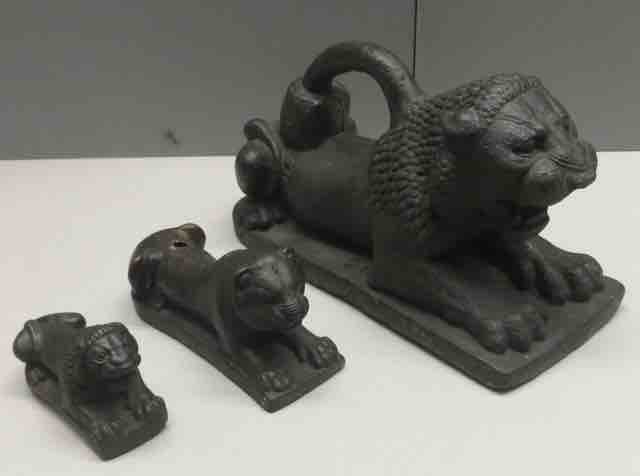Artifacts produced during the Assyrian Empire range from hand-held to monumental and consist of a variety of media, from clay to bronze to a diversity of stone. While reliefs comprise the majority of what archaeologists have found, existing sculptures in the round shed light on Assyrian numerical systems and politics.
Assyrian Lion Weights

Assyrian Lion Weights
These weights represented one of only two known systems of weights and measures in Mesopotamia at the time.
The Assyrian Lion Weights (800-700 BCE) are a group of solid bronze weights that range from two centimeters (approximately 0.8 inches) to 30 centimeters (approximately 12 inches). Admired as sculptures in the round today, the weights represent one of only two systems of weights and measures in the region at the time. This system was based on heavy mina (about one kilogram) and was used for weighting metals. Additionally, they bear inscriptions in Assyrian cuneiform and Phoenician script, indicating use by speakers of both languages. Eight lions in the set bear the only known inscriptions from the reign of Shalmaneser V (reigned 727-722 BCE).
Statue of Ashurnasirpal II
Statue of Ashurnasirpal II
The king's beard and hairstyle set him apart from his subjects. He holds a sickle as a form of mythological defense and a mace as a symbol of authority.
This magnesite (magnesium carbonate) sculpture of Ashurnasirpal II (9th century BCE) serves as a rare example of sculpture in the round produced during the Assyrian Empire. The kings stands stiffly with a sickle in his right hand (at his side) and a mace in his left, which he holds to his torso. Both objects are symbolic; the sickle was used as a weapon against monsters, while the mace was a symbol of political and religious authority. The inscription on his chest announce his genealogy, titles, and military triumphs. Although the sculpture is stylized, it gives the viewer a glimpse into fashion norms for rulers at the time. The length of the king's hair and beard set him apart from commoners, who would have found such styles impractical.
Lamassu
Lamassu
Each lamassu figure faced a specific cardinal direction.
The lamassu was a mythological guardian figure with large wings, the head of a human, and the body of a lion or a bull. Originally a protective spirit to the households of Babylonian commoners, the lamassu was later adopted by Assyrian royalty to protect political and religious interests. In Assyrian sculpture, lamassu figures bear similar beards and hairstyles to those of Ashurnasirpal II in the sculpture discussed above. These monumental sculptures usually appeared in relief form in pairs at major entrances to cities, palaces, or fortresses. Each lamassu directed its gaze toward one of the cardinal directions, which explains why some look straight ahead and others have their heads turned.
Black Obelisk of Shalmaneser III
Black Obelisk of Shalmaneser III
This limestone obelisk contains 20 registers depicting conquered kings paying tribute to Assyrian power and celebrating the military campaigns of Shalmaneser III.
Erected during a time of civil war (825 BCE), the limestone Black Obelisk of Shalmaneser III is the most intact Assyrian obelisk found to date. Each side consists of five registers of bas reliefs that celebrate the achievements of King Shalmaneser III (reigned 858-824 BCE). Three registers on each side focus on conquered kings from specific regions paying tribute to the Assyrian ruler. The registers at the top and bottom of each side bear an inscription from the annals of Shalmaneser III, celebrating his annual military campaigns.